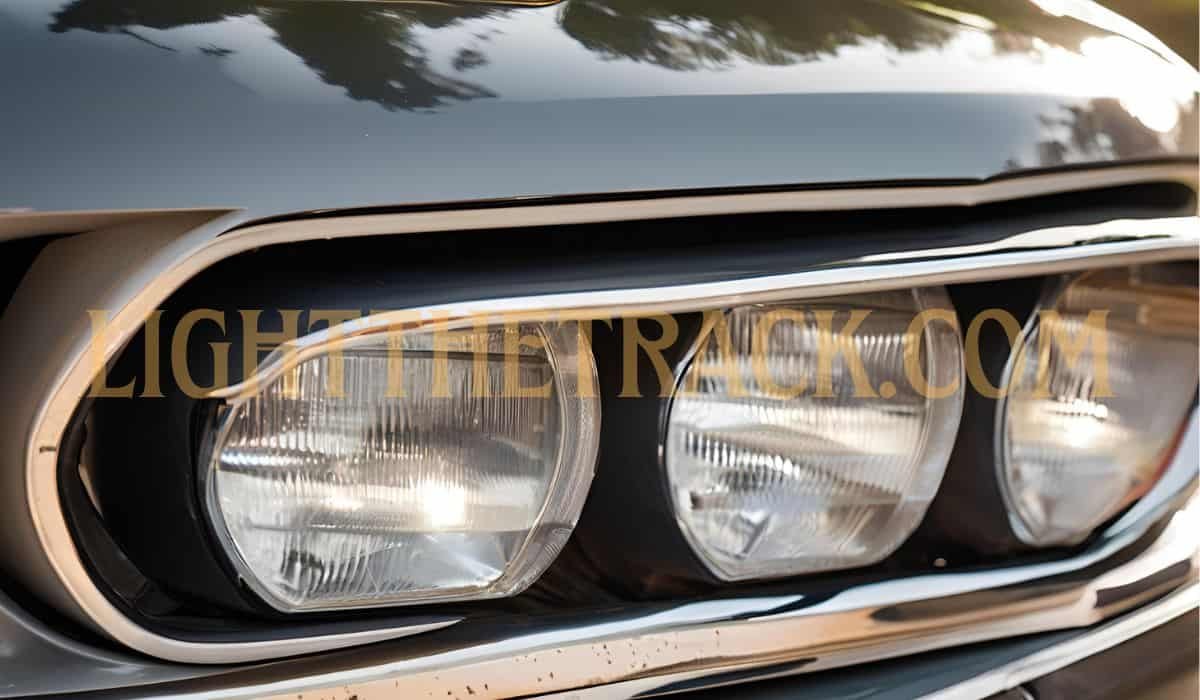Driving at night can be challenging, especially when your headlights aren’t performing at their best. Over time, headlights can become cloudy or yellowed, significantly reducing visibility and compromising safety. But fear not! There’s a simple, cost-effective solution hiding in your pantry: vinegar. In this comprehensive guide, we’ll explore how to restore your headlights to their former glory using this common household item.
Understanding Headlight Oxidation
Before we dive into the cleaning process, it’s crucial to understand why headlights become cloudy in the first place. Headlight lenses are typically made of polycarbonate plastic, which is durable but susceptible to oxidation when exposed to UV rays, pollution, and other environmental factors.
Over time, this exposure causes the plastic to break down and develop a hazy, yellowish appearance. This oxidation not only looks unsightly but also significantly reduces the amount of light that can pass through the lens, diminishing your visibility on the road.
The Science Behind Vinegar as a Cleaning Agent
Vinegar, particularly white distilled vinegar, is an excellent cleaning agent due to its acidic nature. The main component of vinegar is acetic acid, which has a pH level between 2 and 3. This acidity allows vinegar to break down many types of grime, including the oxidized layer on headlights.
When applied to the oxidized plastic, the acetic acid in vinegar helps to dissolve the degraded layer, revealing the clearer plastic underneath. Additionally, vinegar has antimicrobial properties, which can help prevent the growth of mold or bacteria on the headlight surface.
Materials Needed for Cleaning Headlights with Vinegar
Before you begin, gather the following materials:
- White distilled vinegar
- Water
- Spray bottle
- Microfiber cloths
- Protective gloves
- Safety glasses
- Masking tape
- Baking soda (optional)
- Car wax or UV sealant (for protection after cleaning)
Optional items for enhanced results:
- Fine-grit sandpaper (1000-3000 grit)
- Plastic polish
- Electric drill with buffing attachment
Step-by-Step Guide to Cleaning Headlights with Vinegar
A. Preparation
- Park your vehicle in a shaded area to prevent the cleaning solution from drying too quickly.
- Clean the headlight surface with soap and water to remove loose dirt and debris.
- Dry the headlights thoroughly with a clean microfiber cloth.
- Use masking tape to protect the paint around the headlights.
B. Creating the Vinegar Solution
For standard cleaning:
- Mix equal parts white distilled vinegar and water in a spray bottle.
For tougher oxidation:
- Use undiluted white distilled vinegar.
Enhanced cleaning power:
- Mix 2 parts vinegar, 1 part water, and 1 tablespoon of baking soda. (Note: Add baking soda slowly to prevent overflow)
C. Application Methods
1. Spray Bottle Technique
- Spray the vinegar solution generously over the headlight surface.
- Allow it to sit for 1-2 minutes.
- Wipe with a clean microfiber cloth using circular motions.
- Repeat if necessary.
2. Soaking Method
- Soak a microfiber cloth in the vinegar solution.
- Place the soaked cloth over the headlight.
- Let it sit for 5-10 minutes.
- Remove the cloth and wipe the surface clean.
3. Vinegar-Soaked Cloth Application
- Dip a microfiber cloth in the vinegar solution.
- Wring out excess liquid.
- Rub the headlight in circular motions for 2-3 minutes.
- Rinse with clean water and repeat if needed.
D. Scrubbing Techniques
For stubborn oxidation, you may need to apply more pressure or use slightly abrasive materials:
- Use a soft-bristled brush with the vinegar solution for extra scrubbing power.
- For very tough cases, wet a piece of 1000-grit sandpaper with the vinegar solution and gently sand the surface in circular motions. Progress to finer grits (2000, 3000) for a smoother finish.
E. Rinsing and Drying
- Thoroughly rinse the headlights with clean water to remove all vinegar residue.
- Dry the headlights completely with a clean, lint-free microfiber cloth.
- Inspect the headlights in good lighting to ensure all cloudiness is removed.
F. Applying a Protective Coating
To maintain the clarity of your newly cleaned headlights:
- Apply a thin layer of car wax or a specialized UV sealant.
- Allow the protective coating to dry according to the product instructions.
- Buff with a clean microfiber cloth for a glossy finish.
Tips for Maximizing Results
- Clean headlights on a cool, overcast day to prevent rapid drying of the vinegar solution.
- For best results, clean your headlights every 3-6 months, depending on your local climate and driving conditions.
- If you live in an area with high UV exposure, consider applying a UV-resistant clear coat after cleaning.
Comparing Vinegar to Other Headlight Cleaning Methods
Here’s the rearranged table:
| Method | Pros | Cons |
|---|---|---|
| Vinegar | Inexpensive, eco-friendly, readily available | May require multiple applications for severe oxidation |
| Commercial Kits | Often include multiple steps for thorough restoration | More expensive, may contain harsh chemicals |
| Professional Detailing | Guaranteed results, saves time | Most expensive option, requires scheduling |
| Other Household Products (e.g., toothpaste) | Readily available, can be effective for mild oxidation | May be abrasive, results often temporary |
Preventing Future Oxidation
To keep your headlights clear for longer:
- Regularly wash your car, including the headlights.
- Apply a UV-resistant sealant every 6-12 months.
- Park in shaded areas or use a car cover when possible.
- Consider applying a clear protective film to your headlights.
Troubleshooting Common Issues
- Stubborn oxidation: For extremely cloudy headlights, you may need to repeat the vinegar cleaning process several times or consider wet sanding before applying the vinegar solution.
- Uneven cleaning results: Ensure you’re applying even pressure and using consistent circular motions across the entire headlight surface.
Environmental and Cost Benefits of Using Vinegar
Using vinegar to clean your headlights is not only effective but also environmentally friendly and cost-efficient. Unlike many commercial cleaners that contain harsh chemicals, vinegar is biodegradable and non-toxic. It’s also significantly cheaper than most headlight restoration kits or professional services.
Cost comparison:
- Vinegar method: Approximately $2-$5 per cleaning
- Commercial headlight restoration kit: $15-$30
- Professional headlight restoration: $50-$100 per pair
Safety Precautions When Cleaning Headlights
While vinegar is generally safe to use, it’s important to take some precautions:
- Wear protective gloves to prevent skin irritation from prolonged exposure to vinegar.
- Use safety glasses to protect your eyes from splashes.
- Work in a well-ventilated area, especially if using undiluted vinegar.
- Keep vinegar and other cleaning materials out of reach of children and pets.
Legal Considerations
It’s important to note that in many jurisdictions, headlight clarity is part of vehicle safety inspections. Excessively cloudy or yellowed headlights can result in failed inspections or even traffic citations. By maintaining clear headlights, you’re not only improving your safety but also ensuring your vehicle remains compliant with local regulations.
Writer’s Opinion: The Vinegar Method – Pros and Cons
As someone who’s tried various headlight cleaning methods over the years, I find the vinegar approach to be a mixed bag. On one hand, it’s incredibly cost-effective and environmentally friendly, which are big plusses in my book. I’ve had good success with mildly oxidized headlights, achieving noticeable improvement with minimal effort.
However, for severely clouded headlights, I’ve found that the vinegar method often requires multiple applications and can be quite time-consuming. In these cases, a commercial restoration kit or professional service might be more efficient, albeit more expensive.
That said, I still recommend trying the vinegar method first, especially for regular maintenance. It’s a great way to keep your headlights clear if done consistently, and the low cost means you can clean them more frequently without breaking the bank.
FAQ Section
How often should I clean my headlights with vinegar?
For maintenance, clean your headlights every 3-6 months. In areas with high UV exposure, you may need to clean them more frequently.
Can I use any type of vinegar to clean headlights?
White distilled vinegar is best due to its higher acidity and lack of coloring. Apple cider vinegar can work but may leave a slight tint.
Is the vinegar method safe for all types of headlights?
While generally safe for polycarbonate lenses, always test on a small, inconspicuous area first. Avoid using on glass headlights.
What should I do if the vinegar method doesn’t work?
For stubborn oxidation, try repeating the process or consider using a commercial headlight restoration kit or professional service.
Can I use vinegar to clean the inside of my headlights?
No, vinegar should only be used on the exterior lens. Cleaning the inside requires disassembly and should be done by a professional.
Will cleaning with vinegar remove deep scratches from headlights?
Vinegar alone won’t remove deep scratches. For scratches, you’ll need to use sandpaper or a polishing compound.
How long does the vinegar cleaning effect last?
The duration varies depending on environmental factors, but typically, the effects can last 3-6 months with proper care.
Can I combine vinegar with other household cleaners for better results?
It’s not recommended to mix vinegar with other cleaners, as this can create harmful fumes. Stick to vinegar and water or vinegar and baking soda.
Is it necessary to remove the headlight assembly before cleaning?
No, you can clean the headlights while they’re still attached to the vehicle. Just be sure to protect surrounding areas with masking tape.
How does the vinegar method compare to professional headlight restoration?
The vinegar method is more affordable and convenient but may not be as effective for severe oxidation. Professional restoration often includes wet sanding and specialized coatings for longer-lasting results.
Conclusion
Cleaning your headlights with vinegar is an eco-friendly, cost-effective way to improve your vehicle’s appearance and safety. While it may require some elbow grease and patience, the results can be impressive, especially for routine maintenance.
Remember, clear headlights are not just about aesthetics; they’re crucial for safe night driving. By incorporating this vinegar cleaning method into your regular car care routine, you can ensure better visibility on the road and potentially avoid costly replacements or professional restorations.
Whether you’re a DIY enthusiast or simply looking to save some money on car maintenance, give this vinegar method a try. Your wallet—and your fellow drivers—will thank you for it.


Leave a Reply